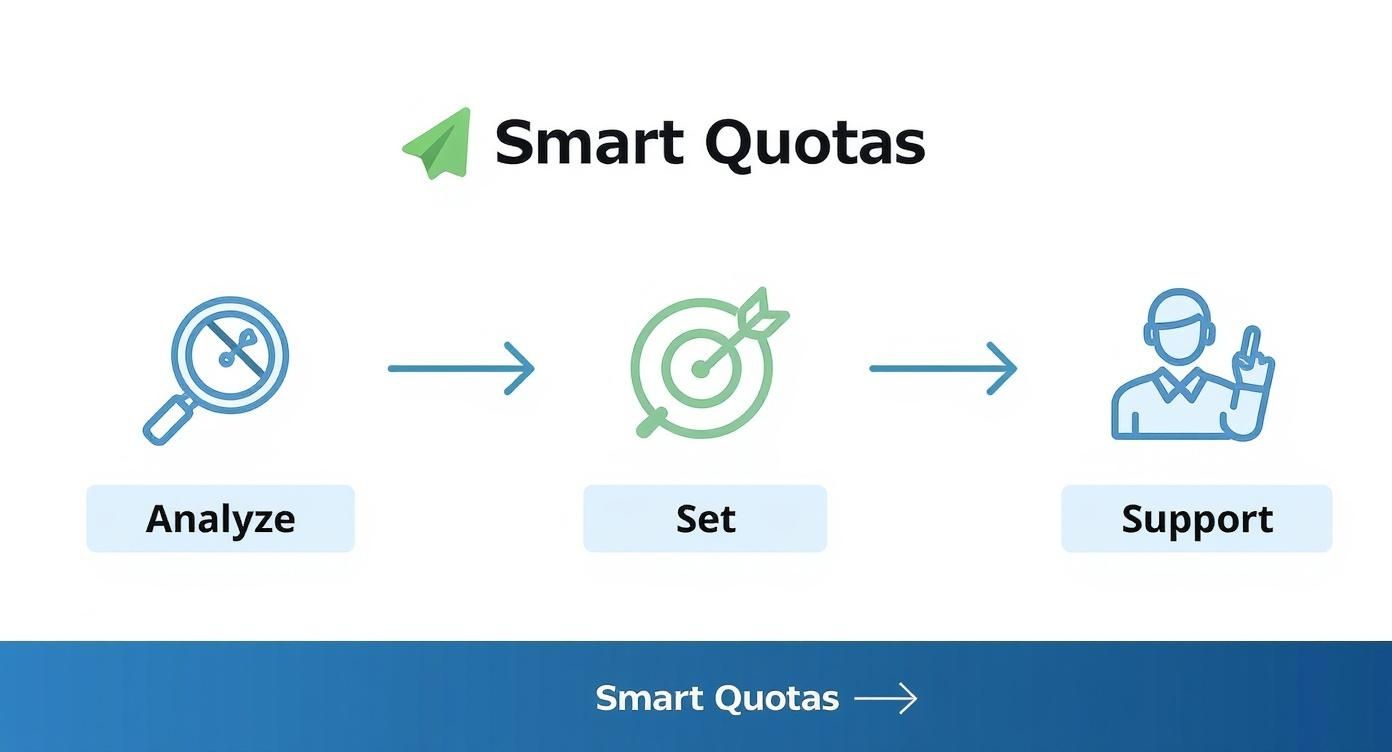How to Improve Sales Team Performance: A Practical Guide
Before you can even think about improving your sales team's performance, you have to get brutally honest about where things stand today. It’s a step too many leaders skip, eager to jump straight into new strategies. But without a clear, data-backed baseline, you're just guessing.
You need a map of your current reality. This initial audit isn't just about looking at last quarter's revenue; it’s about digging into the how and why behind those numbers. This deep dive will inform every single decision you make from here on out.
Establishing a Clear Performance Baseline

Trying to boost performance without a baseline is like trying to navigate a new city without a map. You might stumble in the right direction, but you’ll waste a lot of time and energy on dead ends. A proper audit moves you beyond surface-level stats and gets to the core of your team's operational health.
This isn't just about finding problems. It's also about spotting what's already working so you can replicate that success across the board.
Auditing Your Current Sales Process
First things first: map out your entire sales process. I mean every single step, from the moment a lead enters your world to the final signature on a contract. This is an exercise in discovery, not judgment.
Get the team involved. Grab a whiteboard or use a simple flowchart tool and document every stage. You'll be amazed at what you uncover. Often, you'll find that what you thought was the process isn't what's actually happening on the ground. One rep might be sending five follow-ups while another stops at two. These inconsistencies are performance killers.
As you map it out, ask these critical questions:
- What are the concrete stages of our sales funnel? List them out—"New Lead," "Discovery Call," "Demo," "Proposal," "Closed Won."
- What are the specific entry and exit criteria for each stage? What exact action moves a deal from "Discovery" to "Demo"? Get granular here.
- How long do deals typically sit in each stage? This is where you’ll find your bottlenecks. If deals are dying in the "Proposal" stage, that's where you need to focus.
A solid sales enablement framework is the backbone of this whole effort. It’s what turns a chaotic, inconsistent process into a well-oiled machine by giving reps the exact content, tools, and training they need at every single stage.
Analyzing Individual and Team Metrics
With the process mapped, it’s time to layer in the performance data. We need to look beyond the overall revenue number and get into the nitty-gritty of the Key Performance Indicators (KPIs) that actually drive results.
Top-line revenue is a lagging indicator—it tells you what already happened. You need to focus on the leading indicators that predict future success.
For instance, if a rep is missing their quota, is it because their close rate is low, or are they simply not getting enough qualified meetings on the calendar? Those are two completely different problems with two very different solutions. Without specific data, you’re just coaching in the dark.
Key Performance Indicators to Track
A healthy dashboard gives you a 360-degree view by blending different types of metrics. I recommend focusing on these three categories:
- Activity Metrics: This is the pure effort. Think calls made, emails sent, and meetings booked. It shows you who is putting in the work.
- Pipeline Metrics: This is all about the health and velocity of your funnel. You're looking at things like lead response time, stage-to-stage conversion rates, and average deal size.
- Outcome Metrics: These are the bottom-line results. Here, we track quota attainment, win rate, and customer acquisition cost (CAC).
Pulling this data together and making sense of it is where the magic happens. To truly turn these numbers into a strategic advantage, it helps to understand https://makeautomation.co/what-is-business-intelligence-reporting/. This is how raw data becomes the clear, actionable insight that guides your entire strategy.
By taking the time to build this detailed baseline, you're swapping assumptions for facts. You now have a data-driven starting point that clearly shows your strengths and exposes the weaknesses that need your attention. This foundation is the first and most critical step toward building a higher-performing sales team.
Setting Quotas That Motivate, Not Demoralize
Let's be honest. The right sales quota feels like an exciting challenge—a tough but reachable summit. The wrong one? It feels like you've been asked to climb Everest in flip-flops. It’s not just hard; it’s completely demoralizing. When you pull numbers out of thin air, you risk burning out your top people and making new hires feel like they were set up to fail from day one.
A smarter, data-driven approach turns quotas from a source of dread into a real motivator. When you get it right, quotas perfectly align individual ambition with the company's financial goals. It creates a clear roadmap to victory for everyone involved, and that's a cornerstone of improving any sales team's performance.
Ditching the One-Size-Fits-All Quota
One of the most common missteps I see is slapping the same quota on every single rep. Think about it: a veteran salesperson with a rich territory full of established relationships has a huge head start on a new hire who's building a pipeline from absolute zero. A blanket number for both is just a recipe for frustration.
Effective quotas have to be personal and rooted in reality. You need to factor in a few key variables to make sure they're both fair and ambitious.
- Territory Potential: No two territories are the same. You have to look at the total addressable market (TAM), how saturated it is with competitors, and its historical performance. A rep in a booming, high-growth city should naturally have a different target than someone covering a more spread-out, developing region.
- A Rep’s Experience Level: A rookie needs time to get their bearings. It makes sense to implement a tiered system where their quota increases gradually over their first 6-12 months. This gives them a real chance to learn the product, build a solid pipeline, and find their confidence without being crushed by unrealistic expectations.
- Historical Performance Data: Your own past performance is the best place to start for a realistic baseline. Dig into individual and team win rates, average deal sizes, and how long a typical sales cycle lasts. This data grounds your goals in what you already know is possible.
The real objective isn't just to set a target; it's to build a story of success. A well-crafted quota tells a rep, "Based on what we know and what you're capable of, we believe you can hit this. And we're going to help you do it." That simple shift changes the entire dynamic from pressure to partnership.
Building Quotas from the Bottom Up
Instead of starting with a massive annual revenue goal and just dividing it by the number of reps (the top-down method), try flipping the script. A bottom-up approach gives you a much more realistic picture of what your team can actually achieve.
Start by figuring out how many deals an average rep can realistically close in a month. For example, if a rep's win rate is 25% and their average deal is $5,000, they need to generate four qualified opportunities to land one sale. To hit a $20,000 monthly quota, they need to close four deals. Working backward, that means they need 16 qualified opportunities in their pipeline.
This kind of reverse-engineering makes the quota tangible. It's no longer some abstract number hanging over their head. It becomes a clear set of activities they can control, empowering them because they know exactly what they need to do each week to stay on track.
Why Transparency and Support Are Everything
Here's a wild statistic: while 100% of sales leaders say team performance is their biggest challenge when setting quotas, a staggering 87% admit they have no structured process for figuring out those targets. That disconnect is a massive source of demotivation. Thankfully, the tide is turning. 100% of leaders now provide extra coaching for reps who are falling behind, which shows a much-needed shift toward a more supportive culture. You can see more on how companies are approaching this in a report from The Sales Collective.
This kind of support system isn't optional; it's essential. Once quotas are set, your job as a leader is to provide the coaching, tools, and training your team needs to hit them.
- Be transparent about your method. Walk the team through how their quotas were calculated. When people understand the logic behind the numbers, they're far more likely to accept them as fair.
- Check in regularly. Don't wait until the last week of the quarter to see who's drowning. Weekly one-on-ones help you spot challenges early and offer coaching right when it's needed most.
- Celebrate the small wins. Don't just focus on the final number. Acknowledge a rep for building a great pipeline or for nailing a tough product demo. Recognizing progress keeps morale high and reinforces the daily habits that lead to success.
At the end of the day, a motivating quota is a collaborative tool, not a weapon. It should be a shared goal that brings the team together, clarifies what's important, and sets a clear benchmark for what great performance really looks like.
Designing a High-Efficiency Sales Process
A motivated team with ambitious goals can still stumble if their process is a mess. When reps are drowning in admin work, wrestling with confusing workflows, or reinventing the wheel on every deal, they aren’t selling. They’re just busy. The secret to unlocking their real potential is building a lean, repeatable, and efficient sales process from the ground up.
This isn't about micromanaging. It's about getting rid of the friction that holds your team back and creating a system that lets your sellers do what they do best: build relationships and close deals.
This infographic breaks down a smart framework for improving your team's process—it all starts with solid data analysis, clear targets, and consistent support.

As you can see, a high-efficiency process begins with analysis, moves to goal setting, and is kept alive by continuous coaching and support.
Mapping Your Sales Journey From Start to Finish
You can't fix what you can't see. The very first thing to do is get your entire sales journey down on paper. I mean every single touchpoint, from the second a lead comes in to the moment a deal is marked "Closed Won."
Get your team in a room and map it out visually. You’ll probably discover that the process you think you have is very different from what your reps are actually doing day-to-day. Spotting those disconnects is your first big win.
A crucial piece of this puzzle is defining rock-solid criteria for each stage. What specific action moves a prospect from "Qualified Lead" to "Demo Scheduled"? When everyone is playing by the same rules, your pipeline data suddenly becomes a lot more reliable.
Pinpointing and Eliminating Time Sinks
With your process mapped out, you can start hunting for the bottlenecks and time-wasting activities that are dragging everyone down. The industry data on this is shocking. Sales reps spend only about 35% of their time actively selling, with the rest of the day swallowed by non-revenue tasks. When you consider that only 21% of deals close successfully, you realize how massive the opportunity is to tighten things up.
Look for the low-hanging fruit—areas where small changes can deliver big results.
- Are your reps spending an hour every afternoon manually logging calls and emails in the CRM? That’s a perfect candidate for automation.
- Are they writing every single follow-up email from scratch? It’s time to build a library of proven templates.
"A great sales process doesn’t just tell a rep what to do next; it makes doing the right thing the easiest possible option. Every automated task, every standardized template, and every clarified stage gives your team back their most valuable asset: time to sell."
Standardizing for Scalable Success
Consistency is the bedrock of a high-performance sales machine. Once you find out what works, you need to standardize it so every single rep can benefit. This usually applies to a few key areas.
First, your follow-up cadences. Define the exact number of touchpoints, the timing between them, and the mix of channels (email, phone, social) you should use for different lead types. This is how you stop prospects from falling through the cracks.
Second, your CRM workflow must be non-negotiable. Set clear rules for logging activities, updating deal stages, and capturing key info. This kind of data hygiene is what makes accurate forecasting and performance analysis possible.
Time Sink vs. Time Saver Activity Comparison
To really see the impact of this shift, it helps to compare common manual tasks with their more efficient, tech-enabled alternatives. This isn't just about shaving off a few minutes here and there; it's about fundamentally changing how your team operates and where they focus their energy.
| Common Time Sink Activity | Time-Saving Alternative | Impact on Performance |
|---|---|---|
| Manual Data Entry | CRM automation that logs calls and emails automatically. | Reclaims hours per week for prospecting and follow-ups. |
| Writing Emails from Scratch | Using proven email templates with personalization tokens. | Speeds up outreach and ensures consistent, effective messaging. |
| Guessing at Lead Priority | Implementing an automated lead scoring system. | Focuses rep attention on the hottest, most engaged leads. |
This structured approach transforms your sales operation from a series of individual efforts into a cohesive and predictable engine for growth.
Of course, the right tools are essential for making this happen, which is why having effective sales pipeline management software is so important. By automating the mundane, you empower your team to focus on the human element of selling—where the real value is created. It's all about building a system that supports, rather than hinders, your top talent.
Using Tech and AI to Give Your Sales Team an Edge
In sales, the right technology isn’t just a nice-to-have anymore—it’s a force multiplier. But it's easy to get bogged down by the sheer number of tools out there.
Smart technology doesn't create more work; it gets rid of it. The real goal is to stop chasing every shiny new gadget and start strategically integrating tools that solve the real-world problems your team bumps into every single day. When you get this right, you empower your team to work smarter, not harder, which is the cornerstone of improving sales performance for the long haul.
Nail Down Your Core Sales Stack First
Before you even glance at a flashy AI tool, you have to get your foundation solid. That starts and ends with your Customer Relationship Management (CRM) system. All too often, a CRM becomes a glorified digital filing cabinet instead of the dynamic command center it was designed to be.
The first move is making sure your CRM is a perfect mirror of your actual sales process. Every single stage, custom field, and automated workflow should directly map to the steps your reps take to close a deal. When the CRM works with them instead of against them, adoption rates go through the roof, and the quality of your data improves almost overnight.
This dashboard from a modern sales CRM shows just how powerful centralizing information can be.
A view like this gives reps a clear, immediate snapshot of their pipeline's health, what’s on their plate for the day, and how they're tracking toward their goals. No more guesswork.
Layer on Sales Intelligence Platforms
Once your CRM is dialed in, the next layer is sales intelligence. These platforms go way beyond basic contact info, offering deep insights into companies and the people who work there. Think of them as your team's built-in, on-demand research department.
They can unearth valuable intel like:
- Company firmographics: Details on company size, revenue, and industry.
- Technographic data: A look at what software and tools a prospect already has in their stack.
- Buying signals: Things like a company expanding into a new market, hiring for key roles, or a surge in online activity around a specific topic.
This kind of intelligence lets your reps craft much more personal and timely outreach. Instead of a generic pitch, they can reference a recent company announcement or a new product launch, instantly making their approach more relevant and cutting through the noise. To really fill your pipeline, you can explore some of the best lead generation tools that bring these kinds of qualified prospects to your doorstep.
Integrate AI for a True Competitive Advantage
This is where you can see some of the most dramatic performance boosts. AI isn't here to replace your reps; it’s here to make them superhuman by automating the soul-crushing tasks that eat up their time.
One of the most powerful applications I've seen is AI-powered lead scoring. Instead of reps manually sifting through a massive list of leads, AI can analyze thousands of data points—from website behavior to email engagement—and instantly surface the prospects who are hot and ready to buy right now. For a closer look, our guide on how AI-powered lead generation works shows how this can focus your team's energy where it counts.
Another game-changer is AI-driven conversation intelligence. These tools analyze sales calls to pinpoint what your top performers are doing differently, flag common objections, and even pop up real-time coaching prompts to reps while they're live on a call.
The impact here isn't just theory; it's backed by hard numbers. Recent data shows that nearly 60% of sales teams are on track to meet or beat their revenue targets, and a huge reason is their use of AI automation and adaptive strategies. Teams that go all-in on tech are seeing real results: 91% report stable or growing win rates, and 68% have seen a year-over-year improvement in lead quality, according to the HubSpot Sales Strategy Report.
Ultimately, success hinges on getting genuine buy-in from your team. You can't just drop a new tool in their lap and expect magic. Involve them in the selection process, give them great training, and be crystal clear about how this new tech will make their lives easier and help them crush their numbers. When your team sees technology as a partner, not a pain, you unlock its true potential.
Building a Culture of Continuous Sales Coaching

The best sales teams aren't just hired; they're built from the ground up and constantly refined. If you want to see a real, lasting impact on performance, you have to move past the occasional annual training workshop. The key is creating a vibrant culture where continuous, hands-on coaching is part of the daily fabric.
Think of it this way: one-off training is like giving someone a fish, while a coaching culture is like teaching them how to fish. One solves a problem for a day, but the other builds a sustainable engine for high growth.
This requires a fundamental shift in the role of a sales manager. They need to evolve from being simple overseers who just review numbers to becoming world-class coaches. Their main job becomes actively developing the skills and confidence of every single person on their team. It’s an ongoing dialogue, not a once-a-quarter lecture.
From Theory to Practice: Real-World Coaching Techniques
Generic advice doesn't close deals. Effective coaching has to be tied to actual sales scenarios—breaking down real conversations, practicing specific skills, and providing feedback a rep can use on their very next call.
Forget abstract theories. You need to focus on practical, hands-on methods that build real muscle memory and competence. The goal is to create a safe space for reps to fail, learn, and grow without the pressure of a live deal hanging in the balance.
Here are a few powerful techniques I’ve seen work wonders:
- Live Call Reviews: Sit in on live calls or listen to recordings with a specific focus. Don't just hunt for mistakes. Look for moments of excellence you can highlight and share with the whole team. A good rule of thumb is to provide one piece of positive feedback and only one specific, actionable area for improvement.
- Targeted Role-Playing: Don't just say, "Let's role-play." Get granular. For instance, run a session dedicated only to navigating the "we don't have the budget right now" objection. Arm the "prospect" with the top three ways customers say this and drill the reps until their responses are sharp, natural, and confident.
- Deal Strategy Sessions: Your pipeline reviews are goldmines for coaching. Instead of just asking for status updates, pick a deal that's stalled and brainstorm the next steps as a team. This kind of collaborative problem-solving teaches critical thinking and exposes reps to strategies they might not have considered.
Creating Personalized Development Plans
No two salespeople are the same. A star closer might struggle with initial prospecting, while a fantastic relationship-builder gets nervous during price negotiations. A one-size-fits-all coaching plan will always leave people behind and fail to maximize everyone's potential.
This is exactly why personalized development plans are so critical. These aren't performance improvement plans for people who are struggling; they are growth roadmaps for everyone. Sit down with each rep and work together to identify one or two core skills they want to develop over the next quarter. This collaboration ensures their buy-in and turns the coaching process into a genuine partnership.
For example, a plan for a newer rep might focus on mastering the discovery call, while a senior rep's plan could be centered on breaking into enterprise-level accounts.
A great coach doesn't just point out weaknesses. They help each rep identify their unique strengths and build a development plan that turns those strengths into superpowers, ultimately elevating the entire team's performance.
Mastering Advanced Sales Competencies
Once you have a solid foundation, you can start equipping your team with the advanced skills that separate the good from the truly great. These are the competencies that allow reps to navigate complex deals and create massive value for their clients.
- Consultative Selling: This is all about shifting the mindset from "selling a product" to "solving a business problem." Train your reps to ask deeper, more insightful questions that uncover challenges the prospect might not have even articulated yet.
- Objection Handling: It's time to move beyond canned responses. Teach your team to see objections not as roadblocks, but as requests for more information. One of the best techniques is the "Feel, Felt, Found" method, which builds empathy before you present a solution.
- Strategic Negotiation: You need to give reps the skills to protect deal value without being confrontational. This involves training on how to establish a clear give-get framework and, just as importantly, how to confidently walk away from a bad deal.
By weaving these coaching practices into your weekly rhythm, you create a powerful feedback loop. Reps become more skilled, confident, and motivated because they see a clear investment in their personal growth. This is how you stop chasing temporary fixes and start building a team that consistently outperforms the competition.
Your Top Sales Performance Questions, Answered
Even with the best-laid plans, you're going to hit snags. Improving a sales team isn't a one-and-done project; it’s a constant cycle of asking tough questions and making smart adjustments. I've been in the trenches, and these are the questions that come up time and time again.
Let's break down some of those real-world challenges that don't always fit neatly into a playbook. Getting these right is often what separates a team that’s just hitting its numbers from one that’s absolutely crushing them.
How Do You Motivate Underperforming Reps?
First things first, you have to figure out why they're underperforming. Poor numbers are just a symptom. In my experience, it almost always boils down to one of two things: a skill problem or a will problem.
A rep with a skill gap needs coaching, not a motivational speech. If their call-to-meeting conversion rate is tanking, don't just tell them to make more calls. Instead, sit with them and run through role-playing exercises on handling objections or sharpening their value proposition.
But if it's a "will" issue—a clear lack of drive—the conversation has to get personal. You need to understand their goals and what motivates them outside of work. The trick is to connect their role back to what they want to achieve. Sometimes, just helping a rep see the path to their own success is all it takes to reignite that fire.
What Is the Best Way to Onboard New Sales Hires?
Throwing a new hire a product manual and a login is a recipe for disaster. A structured, thoughtful onboarding process is your single best investment. The goal for their first 90 days isn't just about hitting a number; it's about building genuine competence and confidence.
A killer program mixes up the learning to keep them engaged. Here’s a structure I’ve seen work wonders:
- Week 1: No selling. Zero. This week is all about soaking up company culture, getting a deep-dive into the product, and truly understanding who your ideal customer is.
- Weeks 2-4: Time to introduce the sales process and the tech stack. The most valuable thing you can do here is have them shadow your A-players on live calls.
- Months 2-3: Introduce a ramped-up quota so they can build momentum without feeling crushed. Pair them with a dedicated mentor for weekly check-ins and deal strategy sessions.
A great onboarding experience can shave weeks, or even months, off a new rep's ramp-up time. Rushing this is probably the most expensive mistake you can make.
How Often Should We Adjust Our Sales Process?
Think of your sales process as a dynamic map, not something carved in stone. As a general rule, a deep, formal review every six months is a great cadence. It’s long enough to collect real data but short enough to prevent bad habits from becoming permanent fixtures.
That said, don't be afraid to make small, tactical changes on the fly. If you suddenly see a huge drop-off at one specific stage in your pipeline for a few weeks straight, jump on it immediately. Don't wait for the six-month review to fix a bottleneck that's bleeding deals right now.
Ready to stop wrestling with inefficient processes and unlock your team's true potential? MakeAutomation specializes in building the automated systems that give your sales team back their most valuable asset: time. We'll help you implement the AI and automation strategies that drive real growth. Discover how we can help at https://makeautomation.co.







